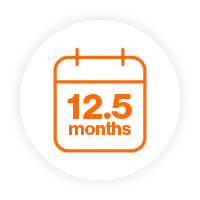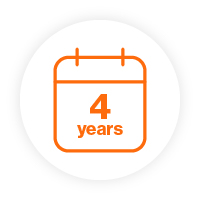

KISQALI® (ribociclib) in eligible patients with HR+/HER2– early breast cancer
Indications:1
KISQALI in combination with an aromatase inhibitor (AI), is indicated for the adjuvant treatment of patients with hormone receptor (HR)-positive, human epidermal growth factor receptor 2 (HER2)-negative early breast cancer at high risk of recurrence (see section 5.1 of the SmPC for eligibility criteria)
In pre/perimenopausal women, or in men, the AI should be combined with a luteinising hormone-releasing hormone (LHRH) agonist
KISQALI is not recommended to be used in combination with tamoxifen.
For information on the safety profile of KISQALI in eBC, click here.
Please consult your local Summary of Product Characteristics for the full KISQALI safety and tolerability profile.

Now you can offer KISQALI + AI to a broad range of your HR+/HER2– eBC patients, including those with N1 and high-risk N0 disease*1,2
KISQALI + Al is indicated for the adjuvant treatment of patients with HR+/HER2− eBC at high risk of recurrence1
Eligible patients include those with lymph node-positive cancer (excluding microscopic nodal involvement) or, if no nodal involvement, either tumour size >5 cm or tumour size 2–5 cm with either grade 2 (and high genomic risk or Ki67 ≥20%) or grade 31

KISQALI can be added as adjuvant treatment for up to 12 months after the start of ET2

KISQALI + NSAI prevented 1 in 4 disease, recurrence or death events over 3 years vs placebo + NSAI (HR=0.75; 95% CI:0.62–0.91, p=0.0014; ARR=3.1%)1,3
In an exploratory 4-year analysis in HR+/HER2– eBC patients, KISQALI + NSAI was observed to reduce the risk of invasive disease, recurrence or death by 28.5% vs NSAI (HR=0.72; 95% CI: 0.61–0.84; p<0.0001 [nominal p-value]; ARR=4.9%)4

KISQALI + NSAI demonstrated a manageable and well characterised safety profile with no new safety signals identified at 4 years1–4
The most common adverse drug reactions (reported at a frequency ≥20%) in the dataset for which the frequency for KISQALI + AI exceeds the frequency for AI alone were neutropenia, infections,nausea, headache, fatigue, leukopenia and abnormal liver function tests1
Please consult the local Summary of Product Characteristics for the full KISQALI safety and tolerability profile.
*KISQALI was evaluated in a randomised, open-label, multicentre Phase III clinical study in the treatment of pre-/postmenopausal women, and of men, with HR+/HER2– eBC with anatomic Stage II or III irrespective of nodal status at high risk of recurrence in combination with an NSAI (letrozole or anastrozole) versus NSAI alone that was:1
Anatomic stage group IIB-III, or
Anatomic stage group IIA that is either:
Node positive or
Node negative, with:
Histologic Grade 3, or
Histologic Grade 2, with any of the following criteria:
Ki67 ≥20%
High risk by gene signature testing
AI, aromatase inhibitor; ARR, annualised relapse rate; CI, confidence interval; eBC, early breast cancer; ET, endocrine therapy; HER2–, human epidermal growth receptor 2 negative; HR, hazard ratio; HR+, hormone receptor-positive; LHRH, luteinising hormone-releasing hormone; NSAI, non-steroidal anti-inflammatory.
References
KISQALI® (ribociclib) Summary of Product Characteristics.
Hortobagyi GN, et al. Ann Oncol 2024. DOI: 10.1016/j.annonc.2024.10.015.
Slamon DJ, et al. New Engl J Med 2024;390(12):1080–1091.
Fasching PA, et al. Oral LBA13. European Society for Medical Oncology Congress 2024,13–17 September, Barcelona, Spain.
UK | July 2025 | FA-11464333
Adverse events should be reported. Reporting forms and information can be found at www.mhra.gov.uk/yellowcard. Adverse events should also be reported to Novartis online through the pharmacovigilance intake (PVI) tool at www.novartis.com/report, or alternatively email [email protected] or call 01276 698370.

